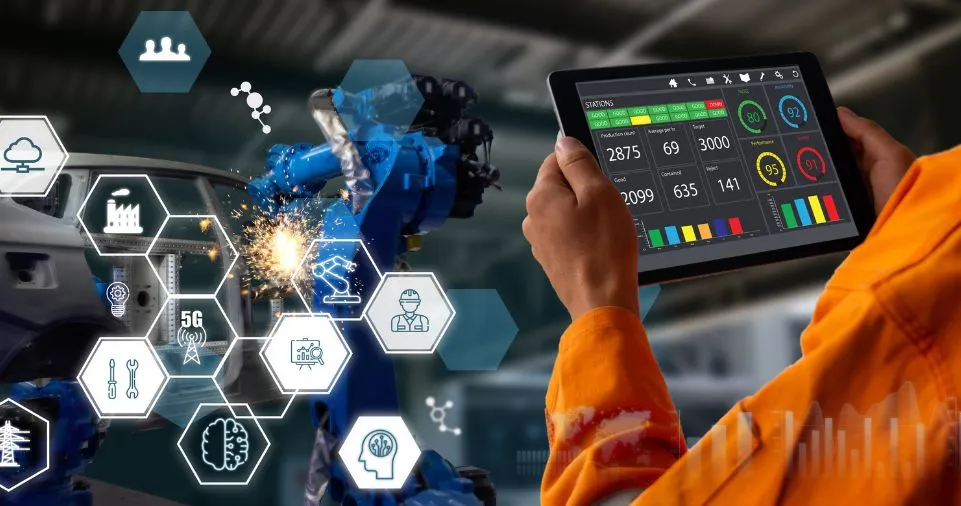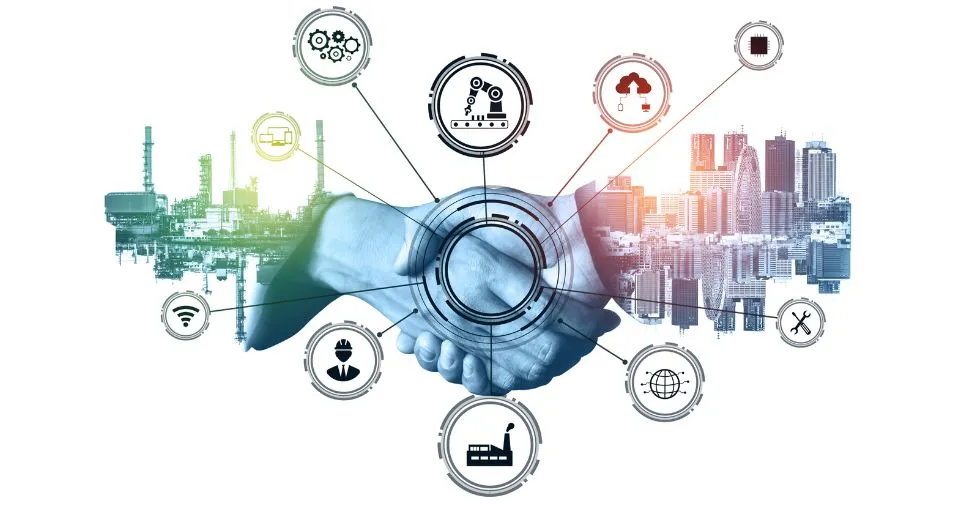Digital Twins revolutionize manufacturing by enabling companies to replicate their Golden Batches or Runs.
By comparing products and their manufacturing conditions, manufacturers can identify the factors causing variability, defects, or inefficiencies, and use this insight to replicate their best production runs consistently.
What is Digital Twin?
A Digital Twin, in general, comprises a real object or system and its digital equivalent. The physical object or system exchanges its data with the digital replica, and the two are linked. This idea was initially proposed in 2002.
The concept is far older, dating back to the 1960s and 1970s, when NASA employed analogue twins of its spaceships for training and simulation reasons prior to and during the Apollo missions.
Data from the supply chain, factory, system, and equipment is used in smart manufacturing.
Manufacturers researching industry 4.0 applications employ the real-time data power of digital twins to monitor and analyse constantly changing information in their production process.
Challenges in Data Utilization

Manufacturers face significant challenges due to the varied systems and formats of production data. Some companies gather extensive raw data but lack the resources to analyze it meaningfully.
This could stem from having employees who are not proficient in data analysis or from an incomplete data connectivity system that hinders the formation of a comprehensive production picture.
Additionally, some organizations struggle with unusable data or complex processes with high data volumes, leading to poor information despite the existence of raw data.
Consequently, manufacturers often struggle to optimize materials, processes, or machines and overlook less obvious sources of variation.
The Role of Digital Twins
Digital Twins help manufacturers overcome data fatigue and leverage data as a competitive advantage. But what exactly is a Digital Twin, and how is it used in manufacturing?
Defining Digital Twins in Manufacturing
A Digital Twin is a digital replica of any process, system, or physical asset that enhances business applications.
In manufacturing, Digital Twins can be built for assets, specific production lines, end products, or any other real-world scenario within a production process.
This technology merges the physical and digital worlds, used for both simulation and operational phases of a product or process lifecycle.
The result is a digital representation that offers deeper visibility and knowledge of production processes.
Every product and process is unique, described by numerous key input variables.
In manufacturing, a Digital Twin captures, maps, and structures process variables into a continuously updated database accessible across the organization.
This data becomes available for use in other applications, models, or third-party programs, enabling meaningful discoveries.
Benefits of Digital Twins in Manufacturing

Digital Twins have emerged as a game-changing technology in manufacturing, providing numerous benefits that enhance efficiency, quality, and innovation.
By creating digital replicas of physical assets, processes, and systems, manufacturers can gain unprecedented insights and control over their operations.
Here are the key benefits of implementing Digital Twins in manufacturing:
1. Improved Process Optimization
Digital Twins enable manufacturers to monitor and analyze their processes in real-time.
By simulating different scenarios and variables, companies can identify inefficiencies and optimize their operations.
This proactive approach leads to more consistent production quality and reduced waste.
2. Enhanced Product Quality
Using Digital Twins, manufacturers can closely track the conditions and variables affecting product quality.
This detailed monitoring helps identify defects early in the production process, allowing for timely adjustments and improvements. As a result, companies can produce higher-quality products consistently.
3. Predictive Maintenance
Digital Twins facilitate predictive maintenance by continuously monitoring the condition of equipment and machinery.
By analyzing data from sensors and other sources, manufacturers can predict when a machine is likely to fail and schedule maintenance before any breakdown occurs.
This reduces downtime and extends the lifespan of critical assets.
4. Cost Reduction
By optimizing processes, improving product quality, and implementing predictive maintenance, Digital Twins help manufacturers significantly reduce costs.
Lower waste, fewer defects, and minimized downtime translate into substantial savings, enhancing the overall profitability of the organization.
5. Accelerated Innovation
Digital Twins provide a virtual environment for testing new ideas and innovations without disrupting actual production.
Manufacturers can experiment with new materials, designs, and processes in the digital realm, allowing for rapid prototyping and faster time-to-market for new products.
6. Increased Flexibility and Agility
With Digital Twins, manufacturers can quickly adapt to changes in demand, supply chain disruptions, or other external factors.
By simulating different scenarios, companies can develop flexible production strategies and respond swiftly to market dynamics, maintaining a competitive edge.
7. Better Data-Driven Decision Making
Digital Twins aggregate data from various sources, providing a comprehensive view of the entire manufacturing process.
This holistic perspective enables informed decision-making based on accurate, real-time data. Managers and engineers can make strategic choices that align with the company’s goals and improve overall performance.
8. Enhanced Collaboration
Digital Twins foster collaboration across different departments within a manufacturing organization.
By providing a shared, accurate view of processes and assets, teams can work together more effectively to solve problems, implement improvements, and innovate.
This collaborative approach leads to better outcomes and a more cohesive working environment.
9. Sustainability and Environmental Impact
Digital Twins help manufacturers achieve sustainability goals by optimizing resource usage and reducing waste.
By monitoring energy consumption and emissions, companies can identify areas for improvement and implement more environmentally friendly practices.
This not only benefits the planet but also enhances the company’s reputation and compliance with regulations.
10. Traceability and Compliance
Digital Twins enable detailed tracking of products throughout the entire manufacturing process.
This traceability ensures that manufacturers can meet regulatory requirements and provide transparency to customers.
In the event of a product recall or quality issue, companies can quickly identify and address the problem, minimizing risks and maintaining customer trust.
Data Accessibility and Digital Twins

Choosing the right type of Digital Twin is essential, but it’s only one part of your digitalization strategy.
The construction of a Digital Twin—how data is collected, modified, mapped, and made usable—significantly impacts your ROI and digital effectiveness.
Advanced Digital Twins continuously collect and contextualize data to include real-time production conditions, accounting for calculated variables when no sensors exist.
This approach transforms production data into interconnected information, available for further visualization, analysis, decision-making, and innovation.
Middleware systems ensure continuous data ingestion, providing teams with updated, accurate production information in real-time.
Empowering Data Utilization
Data is valuable only when it can be utilized effectively. While data scientists benefit from prepared information, manufacturing tools must empower citizen data scientists—process experts with day-to-day operational knowledge.
By democratizing data, companies can foster organization-wide transformation.
Integrating IIoT Platforms and Digital Twins
IIoT Platforms serve as gateways to Digital Twin data, aggregating real-time data from various sources into a centralized environment accessible to a wide range of users.
However, improved data access doesn’t guarantee improved data usability.
Enhancing IIoT Platforms with advanced business applications allows users to gain real-time visibility into production conditions or delve deeper into Digital Twin data using AI to optimize processes and quality.
IIoT platforms democratize data, empowering citizen data scientists. The platform, combined with Digital Twins, serves as a single source of truth, enabling teams to address quality concerns, identify process optimizations, or build predictive models.
5 Uses for Digital Twin Technology in Smart Manufacturing

The advantages and benefits of deploying digital twins in smart manufacturing are numerous.
Digital twins development technology provide firms with predictive insights to meet their business goals, from anticipating maintenance concerns to analysing product updates and informing financial decisions.
Here are five instances of how digital twins are used to meet the various needs of smart manufacturing.
Reduce the Time it Takes for a Product to Reach the Market
Digital twins provide smart manufacturers with the real-time insights they need to make production decisions fast by producing a virtual counterpart connected to the physical asset.
Because physical product delays are eliminated — hardware, labour, materials, and so on — operators can accelerate every step of the production process, including design, development, testing, and maintenance.
Process and Product Performance should be Optimised
Smart manufacturers can predict the quality of the ultimate product by using a digital twin, allowing them to make better informed decisions about material upgrades and process improvements.
Digital twins in industrial manufacturing help to assure uniformity across large-scale production so that the finished product is always in line with requirements.
Boost Production Efficiency
Operators can use digital twins to continuously monitor processes and systems in order to determine the most efficient approaches.
A digital twin will immediately highlight chances for improvement if the production flow isn’t working at peak capacity.
Digital twins assist smart firms achieve their sustainability goals by enhancing production efficiency and lowering energy and material use.
Predictive Maintenance Should be Enabled
Unplanned downtime in smart manufacturing can cost tens of thousands of dollars per hour.
Digital twins enable operators to predict concerns depending on various environmental stresses and scenarios.
Manufacturers can forecast when faults will develop and address maintenance concerns before they disrupt entire production by employing digital twins to look into the interior workings of their complex machines.
Allow for Remote Commissioning
Virtual commissioning allows for the early validation of system designs in order to predict and fix difficulties that occur when equipment and processes are integrated for the first time.
Digital twin technology in smart manufacturing demonstrates how entire systems will interact – not just individual devices, but how each device will influence the functioning of an entire factory floor.
Consider what a digital twin could accomplish for your business. Begin working with RisingMax Inc IT consulting service providers right away.
Actionable Insights from Digital Twins
With a process Digital Twin in place, you can leverage replicas in an IIoT Platform to:
- Test operating conditions and predict results
- Optimize production
- Discover new revenue streams
- Reduce costs, waste, and energy consumption
- Personalize products
- Perform predictive maintenance
- Improve quality and customer satisfaction
- Trace each product from start to finish
Also Read:
Summary
Digital Twins are transforming manufacturing, with the market expected to reach $48.2 billion USD by 2026. While it’s tempting to adopt the first available solution, it’s crucial to consider both short-term and long-term goals.
Ensure that your chosen Digital Twin can adapt to factory changes, support future initiatives, and democratize data usage across your organization, empowering more teams to drive progress.


